Apple Mac mini Review (Mid 2010)
by Anand Lal Shimpi on August 9, 2010 3:37 AM ESTSpin the mini
Apple has done away with conventional feet and instead the mini rests on a circular pedestal. The circular base doubles as an access port to the internals of the mini.
The removable cover has two indentions that you put your fingers in. A counter clock-wise twist (about 1/16th of a rotation) will unlock the cover. Removing it reveals the only easily user replaceable components in the mini: the DDR3 SO-DIMMs.
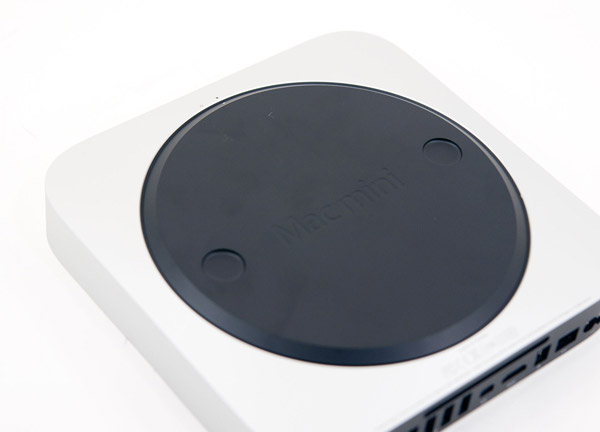
The $699 configuration comes with two 1GB DDR3-1066 sticks. Woefully inadequate for today’s workloads, particularly since the mini only comes with a 5400RPM 2.5” HDD so any swapping to disk is painfully slow.
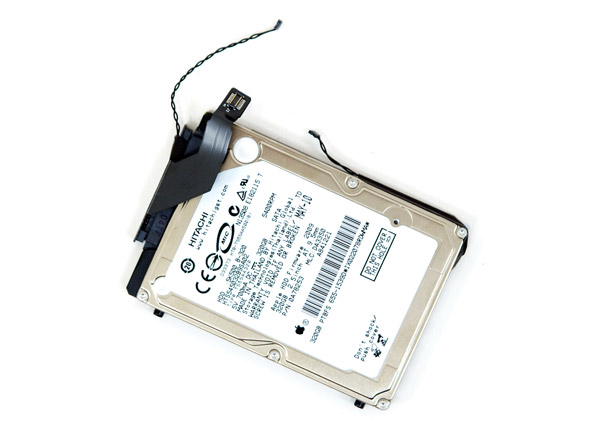
The 2.5" Hitachi 5K500 5400RPM HDD
Replacing memory is as easy as can be on the Mac mini, just remove the cover, pop out the sticks and install new ones. It’s just like a notebook, but easier.

Upgrading the hard drive is much more complicated unfortunately. To get it out you have to remove the motherboard, which isn’t hard but definitely not easy. iFixit has a guide here.
Start by removing the four screws that hold the WiFi antenna in place. Don’t forget to disconnect the antenna cable once you’ve done so.
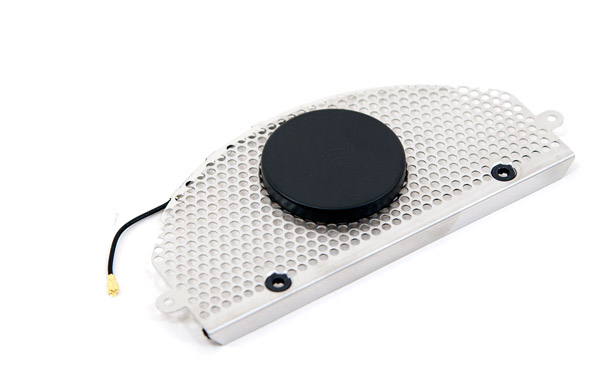

The entire system is cooled by a single fan that channels air through a shroud over a heatsink with a pair of heatpipes. Remove the fan screws, remove the shroud, remove the heatsink screws and then unscrew everything you see on the motherboard and you’re half way there.
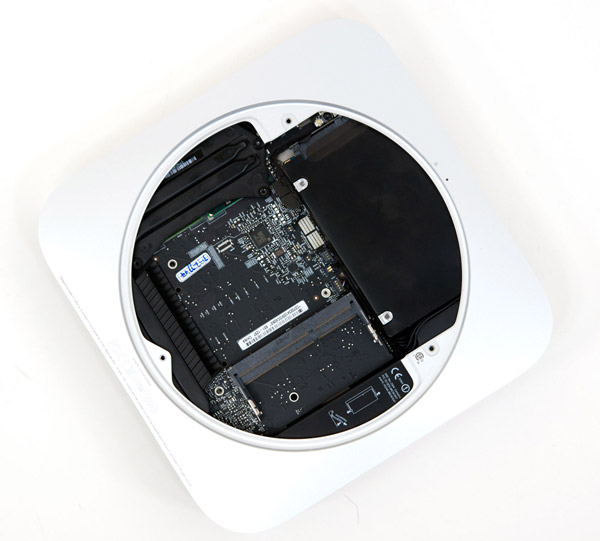
Disconnect all of the temperature sensors and cable connectors from the back of the board and you can finally slide the board out. Unfortunately there’s no easy way to grab onto the motherboard itself so you’re better off sticking two thin screwdrivers through the two open holes in the motherboard and using them to pull the board out of the chassis.
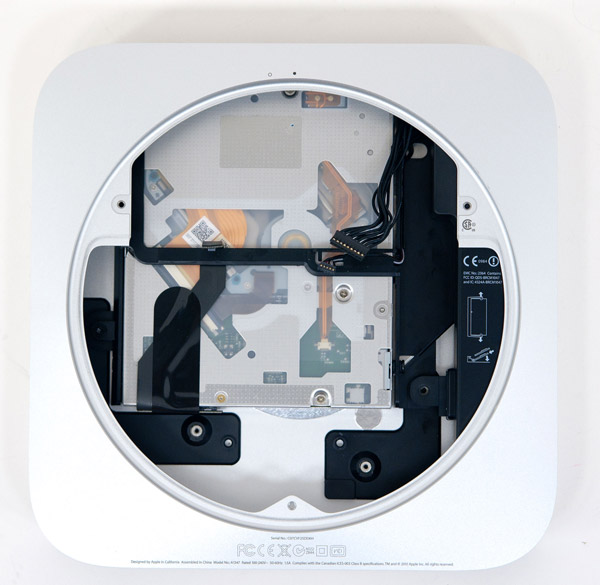
The mini minus a motherboard and HDD
When you’ve done that you can pry the HDD out of its resting spot, unplug its cable and replace it. Ugh.
With the motherboard out we can remove its heatsink and get a bit more personal. Down to the screws in the system, the Mac mini is very much a headless notebook:
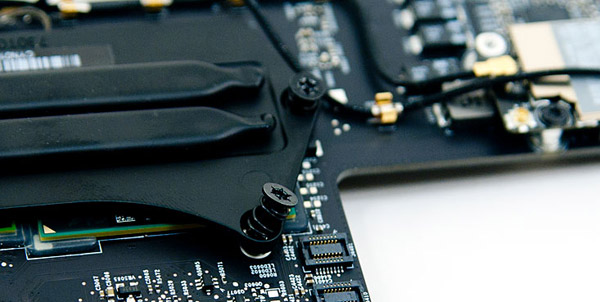
These spring loaded screws are common on notebook heatsinks

Underneath the heatsink we have the two chips that make up the Mac mini: Intel's Core 2 Duo P8600 (right) and NVIDIA's GeForce 320M (left):

The 320M has the graphics, memory controller, SATA controller, PCIe and USB interfaces. Looking at the size of the die you can see how highly Apple values the GPU over the CPU in a system like this. Ten years ago you'd be looking at a four-chip solution (CPU, North Bridge, South Bridge, GPU), today we're down to two. Soon enough we'll be able to have a single SoC that delivers the functionality and performance of these two discrete chips.
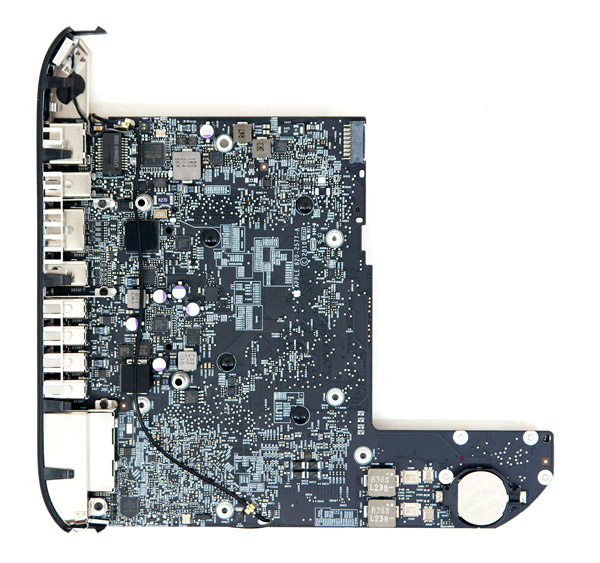










93 Comments
View All Comments
synaesthetic - Tuesday, August 10, 2010 - link
Why all the Apple hate?Price-performance.
Apple doesn't have it.
Smugness.
Apple has too much of it.
kpxgq - Wednesday, August 11, 2010 - link
i think its amazing that this thing uses about the same power (wattage) as my acer revo htpc (single core atom 1.6ghz and ion chipset)... if these thing drop in price, i might pick one up as my main htpc and relegate the revo to the bedroom tvTinksMeOff - Wednesday, August 11, 2010 - link
Needs to start a $599 like before with 2gb of basic ram and offer $799 for the upgraded RAM/CPU/HD Model. The article suggested you can upgrade the RAM yourself and save money. Problem is probably voiding the one year warranty and if you upgrade to the $150 three year protection plan, even more years of voided warranty all to save $30 bucks?You can also upgrade the HD from 320gb to 500gb for $100 more (no option for SSD or 7200rpm HD). The Intel Core 2 Duo CPU can be upgraded from 2.4GHz to 2.66GHz for $150 more.
My existing MAC Mini is the Intel Core Solo 1.5GHz which came with 512MHz DDR2 memory which worked great originally. I upgraded to 1GB (upgradeable to 2GB). I've kept and used it through the years to just look at what Apple is up to and so far I'm able to run the lastest 10.6.4 software with a little lag loading some heavily laden web pages and video. Upgrading to 2gb would probably fix the issue and a Core 2 Dual wouldn't hurt either. I don't play games on the MAC by choice (along time ago) and would never recommend a MAC for PC Gaming over a W7 gaming system.
This latest MAC Mini just gives me no incentive to upgrade my existing one at the price point, but my purpose in using it is strictly internet and MAC experimentation. I would assume many internet and general usage only people will be thinking just like me regarding this new version of the MAC Mini.
Thanks for the thorough article and possible advantages of this MAC Mini model.
thunng8 - Thursday, August 12, 2010 - link
Upgrading RAM does not void the warranty.TinksMeOff - Thursday, August 12, 2010 - link
Thanks for the update, the one I bought would have voided the warranty but you need a putty knife to get the cover off mine and then some work disconnecting some wires 'just so' to reach the ram modules. This model does have all the upgrade ease of a laptop ram upgrade and I was wondering about the warranty is done by the owner.matt b - Wednesday, August 11, 2010 - link
You said that most OS X programs would be perform more like the Cinebench and Quicktime tests . . . I'd like to see more tests. I have a feeling that Cinebench is highly optimized for Intel processors and that Intel has optimized its drivers for the cinebench test. Intel does a lot of work on trying to win benchmarks that are used in tests . . . see the Federal Trade case against Intel. I'd love to see if that was true . . . test some more software that is less rarely used in benchmarks and see if the POWER chip prevails in those as well.derektrotter - Thursday, August 12, 2010 - link
Not sure why people care more about streaming DTS-HD or Dolby Digital out the HDMI than discrete audio. Discrete uncompressed audio is also lossless and more versatile than compressed schemes which are tougher to clip mix and such.But the new Mac Mini also does 7.1 channels of 96KHz/24-bit streaming audio out. VLC doesn't support it correctly (you have to stream instead, with the checkbox that streams out the S/PDIF normally), but someday VLC surely will.
Additionally, PLEX/XBMC do not impress me with their hardware video decoding support. People say they can play about every other frame of a Blu-ray rip? On this Mac Mini VLC can play every frame of a Blu-ray rip. It only bogs down at all on the toughest sections in Avatar (the hardest challenge, as it is full-frame 1.78:1, 44GB file). Video playback acceleration still needs some work on the Mac clearly.
RagingDragon - Sunday, August 22, 2010 - link
If Apple are determined to put OpenCL in all Mac's, then I guess we'll see either: Open CL drivers for Intel i3/i5, or the small form factors Mac's moving to AMD CPU's and and integrated graphics.mbtgood - Tuesday, August 24, 2010 - link
like mbt a lothttp://www.mbt-usa.com
mutarasector - Sunday, November 28, 2010 - link
This system offers more bang for the buc than a Mac mini:http://www.asrock.com/nettop/overview.asp?Model=Vi...